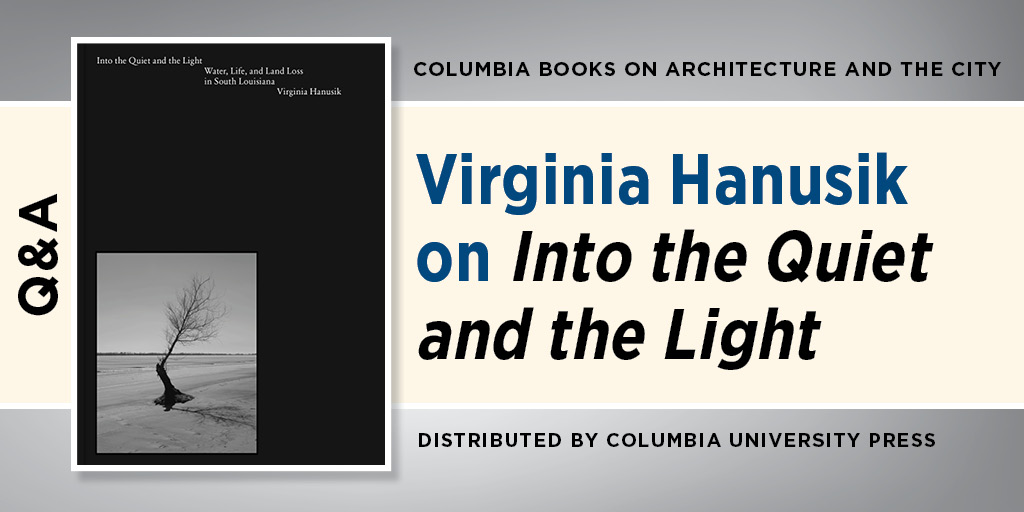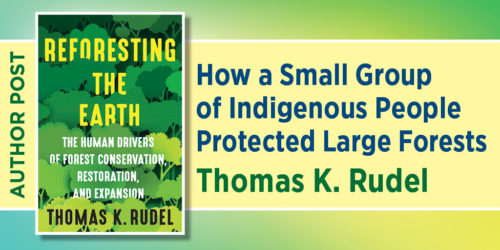Virginia Hanusik on Into the Quiet and the Light

Into the Quiet and the Light: Water, Life, and Land Loss in South Louisiana offers a glimpse into the vulnerabilities and possibilities of living on the water during an ongoing climate catastrophe and the fallout of the fossil fuel industry. Artist Virginia Hanusik’s photographs of the architecture and infrastructure of South Louisiana are paired with microhistories, anecdotes, and insights from scholars, activists, and practitioners working across the region. These reflections soberly and hopefully populate Hanusik’s images, opening up multiple pathways through South Louisiana’s built and natural environments, which defy singularity and complicate the stereotypes often associated with the region and its people. In this Q&A, Hanusik discusses her own practice as a photographer and how it evolved through the conversations shared throughout the book.
Q: Virginia, your book departs from the typical artist’s monograph in that you have invited outside voices to accompany your photographic work. Why was this important for you, for this particular project and for your practice?
Virginia Hanusik: This work is meant to be in conversation with multiple perspectives and experiences of a specific place over time and is a reflection of how I’ve approached my practice while living in Louisiana for almost ten years. It was important for me to include some of the people and ideas that have shaped my own ways of moving through this unique landscape and have informed the way I make my photographs. The book is really a product of years of learning from so many individuals and organizations that are connected to the many histories of Louisiana. A traditional monograph wasn’t a fit for the project in terms of what stories we wanted to tell, especially as they relate to our climate crisis.
Q: This project connects small-scale, informal, and domestic architectures with the monumentality of South Louisiana’s petro-chemical and environmental infrastructures. Can you say more about what draws you to these juxtapositions?
Hanusik: I’m so interested in the ways that infrastructure speaks to how we view our relationships with the land and with each other. I think that especially in this landscape that has been so severely ravaged by the petrochemical industry, what is invested in and valued the most is seen through the construction and maintenance of certain infrastructures—whether that is an actual refinery; the pipelines that supply it; the dredging of the Mississippi River, which makes large-scale transportation possible; or the levees that are meant to hold back the Gulf of Mexico’s encroaching waters.
What “resilience” means is different depending on whom you ask. For so many people across South Louisiana, “resilience” is a blanket term for a system that has abandoned them to the impacts of climate change and has left them to pick up the pieces themselves. There is a limit to the impact we can make as individuals after each storm when there is no systemic change in terms of our reliance on fossil fuels, which will only continue to exacerbate these storms going forward.
I’m drawn to looking at the differences in architecture because they make legible a patchwork approach to adapting to climate change in absence of a robust response by our national leaders.
Q: Your aim with this project was to complicate and challenge common “disaster-oriented” representations of climate change in South Louisiana. Can you explain why such a framing is insufficient for you? And is this problem unique to South Louisiana or can it be thought of more broadly?
Hanusik: The book is framed in a way that makes apparent the role that visual culture has in shaping how we view abstract concepts, especially related to climate change. With this project it was important for me to talk about the history of landscape representation in the United States. I talk about how the idea that certain landscapes were more worthy of preservation or celebration was perpetuated through visual media—painting, photography, film. Louisiana is often portrayed through the lens of the climate crisis, as a place on the frontlines of the impact of climate change. With the book I really wanted to say, (1) Why is this so and who is responsible for it? and (2) What are the limits to visually representing a place? As a visual artist, it was exciting for me to weave together my own perspective with perspectives from contributors who work in other mediums.
Q: What is your own relationship to South Louisiana, and how has your distance or proximity to the region influenced the series you’ve photographed there?
Hanusik: I moved to New Orleans in 2014 after graduating from college in upstate New York. At the time, I was working for an organization that allowed me to connect with people from all over South Louisiana who were involved in the state’s coastal restoration efforts. That experience, ultimately, led to the current focus of my practice. My academic background is in architecture and I was immediately fascinated by the range of building types along the coast—how they vary in style, form, and function, and how they relate to the architecture that exists within more protected areas like New Orleans.
Not being from Louisiana means my perspective will always have a certain distance compared to the lived experience of someone who has generational ties to this land. I didn’t grow up here, so my story and relationship to this landscape is very different. I’m interested in exploring opportunities for connection across geographies that are experiencing the impacts of climate change and the ways these stories can be told.
Q: What do you think artistic mediums like photography afford the struggle against climate change? How do you see your practice engaging with or challenging more empirical work on the matter?
Hanusik: I think our culture often depends on visual media to describe something as complex as climate change within a single image. While making this book I was really influenced by Neil Postman’s work Amusing Ourselves to Death: Public Discourse in the Age of Show Business, which is about what it means to be part of a well-informed society and the ways our contemporary visual culture, especially television, has eroded our ability to understand and engage each other and our environment with nuance. The climate crisis isn’t happening in a vacuum, and I’m interested in finding ways to capture elements present in everyday life that demonstrate both our inherent acceptance of and our resistance to the impacts of a changing landscape.
I don’t see my pictures as stand-alone images meant to convey the entirety of the climate crisis. Instead, I try to capture an emotion or feeling associated with living in this world at a time of ecological degradation—the loneliness and helplessness along with the beauty and the faith.








